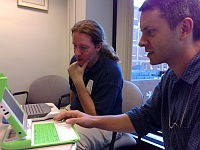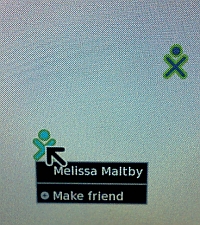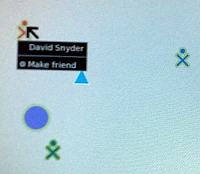With 2,000 new One Laptop Per Child XO B4 computers in the wild, and rumours of Christmas OLPC sales about, software developers are having fun experimenting with the ever-changing Sugar UI builds.
Last week, I had my own "Sugarized" fun time as Jonathan Blocksom and I showcased two XO computers to Rob Pegoraro of the Washington Post.
While we gave a passionate rebuttal to his glowing Classmate review, Jonathan and I found an interesting ability of the newest XO Sugar build: On both the B2 and B4 "mesh view", we could see other computers.
And I'm not talking other XO laptops, but whole other computers that were unrelated to One Laptop Per Child. Lacking local mesh network support, Jonathan asked the Devel mailing list what this might be, and he got a worrying response from Sjoerd Simons:
There is no (real) difference in the telepathy-salut you can install on your normal machine and the one on the XO. So you can talk to each-other.Um, yeah, Sjoerd, I am very worried about abuse. And so is Jonathan. He thinks it is unrealistic to assume someone is "safe" because they access to a machine that was ordered in quantities of 250,000. I think its bad enough we have porn on the XO, we sure don't want unauthorized lurkers inviting kids over to "play" on their computers. Luckily, this isn't technically possible yet according to Dan Williams:Joining the mesh without an XO is hard though (as afaik there are no other machines supporting 802.11s). I'm assuming the Jonathan was using a normal wireless network when he saw others online, not a mesh.
If you're afraid of abuse. How to differentiate your friends and other people/children on the mesh is still subject to discussion.
The mesh has a completely different frame format, so normal laptops are not able to speak olpc mesh. However, to get the mesh stuff up, you have to bring up the normal 802.11 interface in ad-hoc mode, which means it beacons, which means you'll see "olpc-mesh" from other machines.But technical possibility could only be a matter of time as Quanta explores taking its FCC-approved WiFi to the consumer market. A technical possibility that OLPC is working to make visually understandable if and when it happens so children will know who is who and who can do what in their digital world. Something like Eben Eliason's proposed solution:
One direction this might head is one I discussed with Walter several weeks ago, and that is the possibility of changing our scopes to Home, Neighborhood (with friends and groups being selectable filtered subsets therein), and World.Jonathan agrees that OLPC needs to plan for a non-homogeneous computing environment with the XO and consider situations where a cell phone toting parent wants to send a text message to their kid at school. The XO should try to enable, not restrict, cross-platform communication.The World view, then, could take advantage of these "outsiders" and appropriately label them as such so that their presence and abilities within the UI are clear and well defined.
I would only propose that there be teacher and/or parental controls on who can enter a OLPC mesh network and what outsiders can do there, so that children can have a safe place to play and the developing world not have Internet fear-mongering around child predators.





Thanks for your comment Wayan. I have not been following the OLPC development very closely and can’t really comment if his (their) plan is a robust one or not. But I take your word for it as you are much deeper into it than I am. But I do sincerely hope that we can bring education (not laptop) to most (if not all) of the underprivileged children.
By the way, do you know if I can get my hands on an XO machine in Singapore?
Mesh Networking brings up some interesting possibilities - something I worked on a few years ago.
When a wireless networked computer receives an 802.11b/g (and I guess s) transmission, the signal strength is known. By building a table in each computer of the signal strengths of other devices and sharing this table with other computers a 2 dimensional map can be produced.
The scale and orientation of the map would need to be set but relative locations of laptops could be inferred through this system (there is a formula for this and needs at least three signal strengths to plot location on a 2D map).
The 802.15 wireless protocol has already been used in the ZigBEE wireless module and has been developed into a wireless location device http://www.ti.com/corp/docs/landing/cc2431/indextracking.htm
I'd like to see someone develop a location matrix package for the XO (and I wouldn't be surprised if OLPC have experimented already).
I think the XO software developers are well aware of the important security issues with their target audience. Software development is a slow process and I'm sure they are thinking these things through and we will see improvements in them as we have in every other area of the XO software.
I do worry about people who think to "protect the children" they have to lock everything down. Making XOs talk only to XOs is an example of the mistaken path this can lead to; as pointed out in the article above, physical access to an XO is not reliable authentication. And talking to the non-XO world is just too valuable a capability to cut from the design.
I'm also of the opinion that a lot of the people who want to restrict things just don't give kids enough credit. The best security may be every kid having a few trusted adults they can talk to when something doesn't seem right -- and kids will get those feelings. Let's hope the OLPC will put that in the training portion of their implementation plan. They're working on one of those, right?
Wayan,
I am not sure what kind of threat you are refering too.
The XOs now have inbuild regulation of access to projects. The child has to select who will be allowed to cooperate. Every XO uses a cryptographically signed identification key. So it is "very difficult" to maskerade as someone else.
I see no difference between XO and non-XO when you try to "break into" an XO. If you can convince a child to allow you access, you can do that with an XO now too. And you can change the XO software to your heart's content, so security must assume any XO can do everything it's owner want. Even be a link to the NSA computer park.
An "unknown world" environment is anyhow good in any respect. Over the internet, the "neighbourhood" of a Brazilian child could include a Nepalese teacher. Both might want to limit the other in some respect from what they allow local people.
The only thing I can see you might want to regulate is the access to the mesh network. It would be unpleasant if local bussinesses or internet cafes would abuse the mesh network to cut connection costs.
Winter
Winter,
I'm not so worried about the children, I'm worried about parents and community leaders getting all upset when a kid is found associating with the "wrong crowd" be that the NSA or a smut-site if there isn't some level of association control measures (only XO's for example).
Its the parent's expectation of control that the XO threatens. OLPC may think this a good threat, while I see a simple but disastrous parental reaction: no XO + a beating too. In fact, you yourself brought this up when we discussed porn on the OLPC.
OLPC Austria has the new 535 XO firmware running on a B4 and tested the shared activity Paradigma, a chat program like iChat. They even have a video showing how easy it is to automatically invite others on the mesh to chat with you.
http://olpc.lo-res.org/2007/07/shared-activities-video.html
OLPC Community News about Mesh Networks:
Trial-2 testing: Sometimes we easily miss the forest for all the trees, including the hundreds of bugs we deal with.
This week we have a working mesh that does not require access points and operates across the full internet as well, the ability to share most of our basic activities including Chat, Write, Etoys, and Record.
Kim Quirk and Jim Gettys conducted a "train" test (they commute by train without Internet access), which saw successful peer-to-peer picture sharing in the Record Activity and text, audio, and project sharing in the Etoys Activity.
Sharing through the mesh is fun; it got the attention of a number of people on the train.
http://lists.laptop.org/pipermail/community-news/2007-July/000069.html
To Aditya
>I'd like to see someone develop a location matrix package for the XO (and I wouldn't be surprised if OLPC have experimented already).
I'm mucking around with meshing with OLSR in ad-hoc.
In order to the map the network you have the routing table (which says who sees who) and all the link quality stuff.
You can also use 'iwspy' to continously log the signal strength from your (multiple) neighbours. Which I kinda wrote up here:
http://wordpress.calgarymesh.ca/2006/08/09/using-iwspy-to-monitor-signal-strengths-in-ad-hoc-networks/
Cheers,
Simon
OLPC mesh networking grid is live! From Community News http://lists.laptop.org/pipermail/community-news/2007-October/000080.html
Polychronis Ypodimatopoulos has developed a new activity, “Space,” which displays an alternative mesh network neighborhood; it offers a sense of space by placing you in the center and everyone else in the mesh network at a distance proportional to link quality between you and the node that is being displayed. See http://web.media.mit.edu/~ypod/mesh/
I think that children should have the right to use adults computer but they should have something like Cybersitter downloaded.
I think that children should have the right to use adults computer but they should have something like Cybersitter downloaded.
At first, it was a good project, but now, asus is on the market with his 701, less than $299, good quality, design and performance, what is the future of the olpc... don't know, but asus's future will be better.